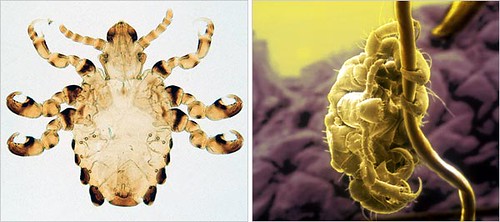Scientists believe they have figured out how and why the human pubic louse, right, and the gorilla louse, left, diverged 3.3 million years ago.
Unlike most other primates, which play host to only one species of louse, humans provide a home to three species of lice. Even more interesting, the closest relative of the human pubic louse is the gorilla louse.
Each of these three species of human louse occupy a different niche on the human body. The head louse, Pediculus humanus, lives among the fine hairs on the scalp as its name implies. Its cousin, the body louse, doesn't live on the body, but instead lives in clothing. And the pubic louse, Phthirus pubis, lives in the the coarser hairs of the pubic area.
By studying human lice DNA, a research a team led by David L. Reed of the University of Florida have learned when humans lost their body hair and also when they began to wear clothes.
For example, they found that the number of DNA differences between the gorilla louse and the human pubic louse indicates that they diverged some 3.3 million years ago. Among people, it is known that the pubic louse is typically spread by sexual contact, but it is possible that the gorilla louse was contracted in some other way.
"We'll never know if it was sex or something more tame," Reed said. What can be said about the lousy transfer, he believes, is that it signals human ancestors had already lost their body hair by 3.3 million years ago, confining the human louse to the head and leaving the groin open to invasion by another louse species.
Further, even though it is likely that humans wore loose garments such as animal skin cloaks, the first tailored clothing would have to have been close-fitting to tempt the head louse to expand its territory. This louse then evolved a new species, the body louse, which has claws adapted for clinging to fabric, not hairs.
In 2003, a geneticist at the Max Planck Institute in Leipzig, Germany, Mark Stoneking, used the DNA differences between the body louse and the head louse to estimate that they speciated about 107,000 years ago. The first tailored and sewn clothes were probably made shortly before this time.
In addition to estimating the divergence between these human lice, Reed and his colleagues also report that the two species of primate lice, Pediculus and Phthirus, probably diverged from each other on an ape host approximately 13 million years ago. This divergence might have happened after lice started to specialize on different parts of the body.
Stoneking said Reed's reconstruction was "pretty reasonable" and he agreed that acquisition of the gorilla's louse indicated people had lost their body hair by then. "The transfer doesn't have to be sexual," he added, "but presumably it does require reasonably close contact."
This research was published in today's issue of the journal Biomed Central Biology.
Cited story.


Maybe it was spread by using gorrila skin for garments ?
Thanks. I now have an itch :o)